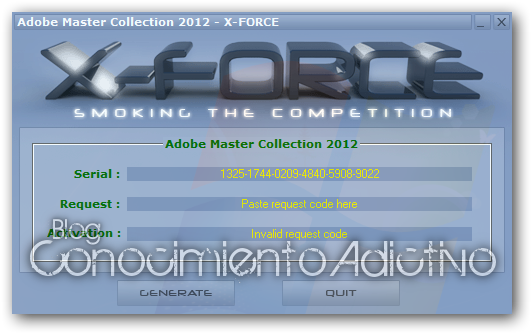
- ADOBE ACROBAT X1 PRO X FORCE KEYGEN INVALID REQUEST CODE PASSWORD
- ADOBE ACROBAT X1 PRO X FORCE KEYGEN INVALID REQUEST CODE OFFLINE

In this specific case, the recipient is the CA as a result.

The SignedData PKCS#7 is signed by the client with one of these certificates it is used to prove that the client sent it and that it has not been altered in transit:.That text string is a Base64-encoded SignedData PKCS#7. The text is then URL Decoded into an ASCII text string.The text after the "message=" is a URL Encoded String, which is extracted from the GET request string.MIIHCgYJKoZIhvcNAQcCoIIG%2BzCCBvcCAQExDjA. The enrollment request is sent as a HTTP GET request. A packet capture for the request looks similar to this: /cgi-bin/pkiclient.exe?operation=PKIOperation&message= This has to be done via an out-of-band method (a phone call to a system administrator or pre-configuration of the fingerprint within the trustpoint). The client needs to validate that the CA certificate is trusted through an examination of the fingerprint/hash. The response is simply the binary-encoded CA certificate (X.509). A packet capture for the request looks similar to this: GET /cgi-bin/pkiclient.exe?operation=GetCACert Response The request is sent as a HTTP GET request. As a result, it is necessary to obtain a copy of the CA certificate. SCEP uses the CA certificate in order to secure the message exchange for the CSR. Re-enroll as necessary in order to obtain a new certificate prior to the expiration of the current certificate.Poll the SCEP server in order to check whether the certificate was signed.Generate a CSR and send it securely to the CA.Obtain a copy of the Certificate Authority (CA) certificate and validate it.
ADOBE ACROBAT X1 PRO X FORCE KEYGEN INVALID REQUEST CODE PASSWORD
Requires the use of a challenge password field within the Certificate Signing Request (CSR), which must be shared only between the server and the requesterĮnrollment and usage of SCEP generally follows this work flow:.
ADOBE ACROBAT X1 PRO X FORCE KEYGEN INVALID REQUEST CODE OFFLINE
Does not support online certificate revocation (must be done offline through other means).Has limited Certificate Revocation List (CRL) retrieval support (the preferred method is through a CRL Distribution Point (CDP) query, for scalability reasons).Supports asynchronous granting by the server, with regular polling by the requester.Uses PKCS#7 in order to convey cryptographically signed/encrypted messages.Uses PKCS#10 as the certificate request format.Request/response model based on HTTP (GET method optional support for POST method).SCEP was originally developed by Cisco, and is documented in an Internet Engineering Task Force (IETF) Draft. This document describes the Simple Certificate Enrollment Protocol (SCEP), which is a protocol used for enrollment and other Public Key Infrastructure (PKI) operations.


 0 kommentar(er)
0 kommentar(er)
